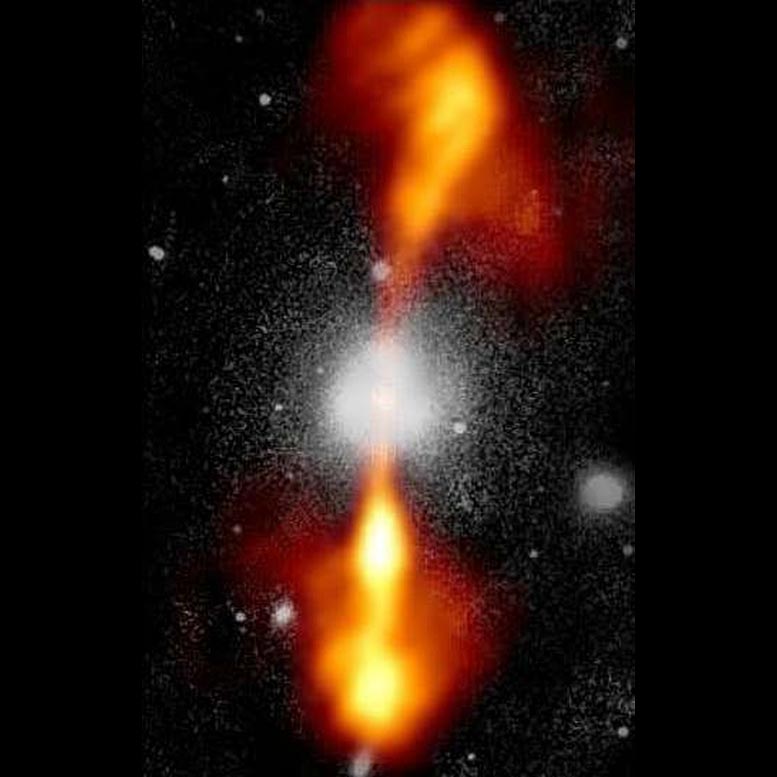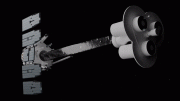
The bright radio galaxy NGC 4261 as seen in visible light (white) and radio (orange), showing a pair of opposed jets emanating from the nucleus. Astronomers have determined that the lobes are about thirty million years old, and were produced from multiple outbursts from around the nuclear black hole. Credit: Wide-Field and Planetary Camera of the Hubble Space Telescope, and National Radio Astronomy Observatory
Using new and archival radio observations, astronomers reveal that the two lobes of radio galaxy 3C 270 are respectively about twenty-nine and thirty-seven million years old and that the lobes are the result of multiple outbursts of activity from the vicinity of black hole.
The longest known highly collimated structures in the universe are the narrow jets that emanate from the vicinity of powerful black holes in certain types of galactic nuclei. These narrow beams, often in pairs propagating in opposite directions, can stretch across millions of light-years. They transport huge amounts of energy from the nuclear black hole regions where they originate into intergalactic space. The jets were discovered at radio wavelengths but they emit at X-ray wavelengths as well because the electrons in the jets move at close to the speed of light. These galaxies are active areas of research both because they are among the most energetic phenomena in the universe and because they are the primary mechanism that injects energy into the clusters of galaxies in which these radio monsters reside.
The development of these jets, their ages, and their ultimate dispositions are only vaguely understood. Astronomers suspect their lives have three phases, starting with the supersonic inflation of lobes of hot gas around the particle jets. It appears that in most sources this first phase is brief. Afterward, the lobes expand gradually until their internal temperatures and pressures drop down to the values of the ambient gas. In the final phase, the jet ejection mechanisms shut down and the associated lobes become unobservable. There are numerous examples of galaxies at these various stages that provide the basis for these notions.
CfA astronomers Ewan O’Sullivan, Diana Worrall, and Mark Birkinshaw, together with four colleagues, examined the jets in the powerful radio galaxy 3C270 (also known as NGC 4261). This source has its brightest radio emission knots closest to the black hole nucleus (the other common type of radio jet galaxy has its brightest regions farthest away from the nucleus). The projected linear scale for the lobes in this source is about 250 thousand light-years at its maximum extent.
The scientists used new and archival radio observations of the lobes, taken at twelve different wavelengths, combined with X-ray observations, to model the emission mechanisms throughout the lobes more precisely than previously done. The multi-wavelength data allow them to map how the character of the emission (i.e., its relative strength at different wavelengths) varies, and to model those variations.
They conclude that the two lobes are respectively about twenty-nine and thirty-seven million years old, contrary to the conventional wisdom that they are about twice as old based on dynamical models. They also conclude that the lobes are the result of multiple outbursts of activity from the vicinity of black hole. The total energy needed to heat these lobes is stupendous, roughly equivalent to the Sun’s total power output over a million billion years, more than the age of the universe.
Reference: “New Insights into the Evolution of the FR I Radio Galaxy 3C 270 (NGC 4261) from VLA and GMRT Radio Observations” by Konstantinos Kolokythas, Ewan O’Sullivan, Simona Giacintucci, Somak Raychaudhury, C. H. Ishwara-Chandra, Diana M. Worrall and Mark Birkinshaw, 28 April 2015, Monthly Notices of the Royal Astronomical Society.
DOI: 10.1093/mnras/stv665









Be the first to comment on "New Insights into the Evolution of Radio Galaxy 3C 270"